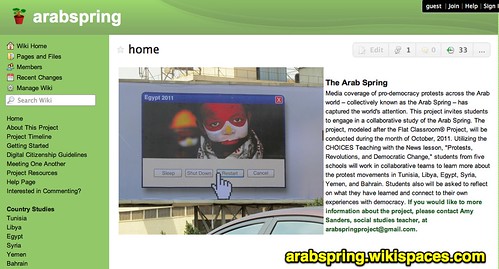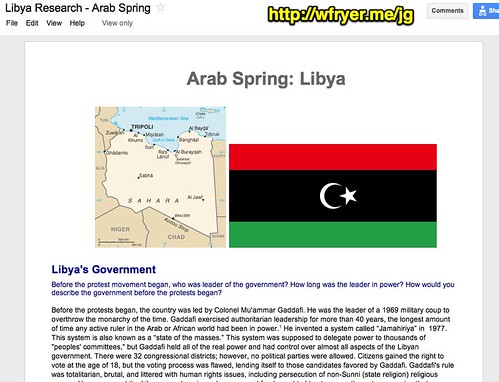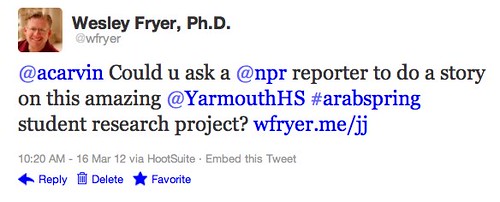UPDATE 12.12.2012: I cross-posted a normalized version of this presentation to “Fuel for Educational Change Agents” podcast channel.
These are my notes from Amy Sanders’ presentation, “Global Collaboration” at the March 16, 2012, professional development day at Yarmouth High School in Yarmouth, Maine. Amy teaches several high school social studies courses, including Arab Studies (last term) and Asian Studies this year. The official session description was:
Rapidly advancing technologies and globalization trends increasingly connect us to communities throughout the world. As educators, how can we prepare students for a world of growing cultural interaction and diversity?
This session will share two collaborative projects undertaken this year and explore how each of these projects gave students an opportunity to:
- investigate the world, including research on significant global issues
- recognize and respond to perspectives different from their own
- communicate ideas effectively with diverse audiences
- develop and practice new skills
- show initiative and work creatively
We’ll share the challenges and successes of these projects, and invite discussion of other collaborative projects.
I recorded this session with permission from Amy and her students. (I’ll use Levellator to normalize this audio and republish this later as a podcast here.)
Global Connections and Exchange (online exchange with Filipino school) – http://gcephil.ning.com/groups/group/show?groupUrl=sanders-photo
Arab Spring Collaborative Research wiki (organizing tool) – http://arabspring.wikispaces.com/
Arab Spring Blog (students share work/encourage dialog) – http://arabspringcomments.blogspot.com/
Over April vacation last year I participated in the Harvard “Egypt Forum” and had an opportunity to travel to Cairo, just 2 weeks after President Mubarak resigned
– Center for Middle Eastern Studies at Harvard
Now sharing a 3 minute video clip, Egyptian students asking questions of U.S. students, wanting to know their perceptions
– many of the teachers participating on our trip wanted to collaborate and have our students in U.S. schools both work together and also
Cathy Wolinski was working on a “Flat Classroom” project at this same time when I came back, so we worked together on this
– it proved more challenging than I thought it would be to organize and coordinate this
We used a wiki as our organizing tool: arabspring.wikispaces.com
At one point we had 250 students involved in the project, we ended up dividing them into six different groups
– each focused on a different aspect / content focus
– we initially page-protected parts of the site where kids were working, they are now all open/public
– we started by having students introduce themselves via video
– this was a great skill
AMY CREATED A SEPARATE YOUTUBE CHANNEL AND VIDEOS WERE SHARED ‘UNLISTED’ BETWEEN CLASSES
Very interesting in the introduction phase, students
– it was easier because of different schedules to use YouTube instead of Skype or a synchronous videoconferencing tool for this
Final Projects are Google Docs
– Example of Libya research document
Other country research:
– Egypt research Google Doc
– Syria research Google Doc
– Tunisia research Google Doc
– Yemen research Google Doc
After that writing, we moved the project over to a public blog for interactive commenting
I’ve received feedback from teachers that their students are using the Google Docs our students collaboratively wrote as their textbook for Arab studies
Collaboration brought up good issues when some students wrote things which were opinions and not evidence-based
– students had to handle this situation with finesse
– it was messy in many ways to have students from different places putting text on these documents
This project really drove home for students the importance of academic citations
– it may not be convenient, but it’s really important in contexts like this to have evidence-based writing, where did you get your support for that idea, etc.
I really hoped we’d be able to get feedback from students in the Middle East on this work
This is a very dangerous project for students actually in the Middle East to share, we didn’t get as much feedback as we’d hoped from the region but understand there are many reasons
The realtime nature of this project helped make this very engaging and interesting for students
– things were continuing to change every day, media sources like Twitter were used by students
I would absolutely do this project again, it was challenging but a very positive experience
This spring I am teaching Asian Studies
– Global Connections and Exchange project is focused on the Philippines
– using Ning as a platform (closed Ning)
– A Day in the Life Photojournals
– Challenges and Successes
About 80% of the students who were in my Arab Studies class are this year in my Asian Studies class
– initial weeks facilitated as students share about themselves, what they are interested in and what they do
Students reported really liking the project, didn’t know very much about the Philippines
– really expanded perceptions about students in the Philippines, students were very eager to ask questions and interact with us
– that made the engagement so much easier: the pictures we exchanged were really key as well
Using a Ning was very different than a public blog… it was harder to have everyone read and respond in some aspects… but I didn’t design this project or lead the facilitation
– a lot of posts could be done at home, were homework assignments
Students reported on the importance of learning about global issues, fostering intercultural understanding
– exposed students to many other cultures and experiences, students learned SO much about different topics
– really helped students appreciate how fortunate they are in many ways living where we do in the U.S., taking many things for granted
Projects gave students a lot of creative capacity
– students could add pictures, look for art
– they were creating it, this was pretty open for students
Having a visual piece is very important for students who tend to be visual learners
Assessment tools:
– for Philippines project: it was a small grade based on homework / work completion
– Arab Spring project was unbelievably hard to assess: students were supposed to share a comment and use a code when they did it, I really “let go” of many things in this project in leaving things more open to
I wish I’d been in contact with country coordinators with iEarn to help assess situations in the ground, if it is save
– project partners in another country
These are links Amy also shared:
Global Collaborative Projects:
http://www.iearn.org/
http://www.flatclassroomproject.org/
http://www.epals.com/
http://www.globalschoolnet.org/
http://www.monsterexchange.org/ (K-6?)
http://myhero.com/go/home.asp
http://www.sitesalive.com/
We didn’t get much mainstream media coverage of our project, except a news agency in Doha, Qatar. They wanted to interview my students when we came (we weren’t’ tea
Ancient game called “Senate”
– 2 person game like Backgammon
– did versions for Bahrain, Syria, let students play these games to build background knowledge
Harvard resources for teaching about the Arab Transformation
MY THOUGHT: HOPEFULLY THIS TWEET WILL BEAR FRUIT FOR MORE FOLKS GETTING AWARE OF THIS AMAZING ARAB SPRING PROJECT AND FACILITATING SIMILAR PROJECTS AT THEIR SCHOOL!
If you enjoyed this post and found it useful, subscribe to Wes’ free newsletter. Check out Wes’ video tutorial library, “Playing with Media.” Information about more ways to learn with Dr. Wesley Fryer are available on wesfryer.com/after.
On this day..
- 3 Ways to Become a More Connected Educator During the COVID-19 Crisis – 2020
- Lessons Gleaned from the Life of Joseph Priestley – 2017
- Don’t Use an AT&T Phone Overseas Without an International Calling Plan – 2016
- Inspired by the First All-Female USAF Boeing E-3 Sentry Air Crew – 2013
- Student “Confession Pages” Trend Highlights Free Speech Issues & Need to Address Ethics / Digital Citizenship – 2013
- Playing With Media Trailer: Modeling Technology Use as the Superintendent – 2012
- Microsoft Copying Apple Store Experience – 2011
- Feedburner Feed and Yahoo Pipe Updated (no longer frozen on Feb 18th post) – 2011
- Terms of Service Agreements Users Don’t Read – 2011
- Install alternate operating systems and software on a netbook via a USB flash drive – 2010



